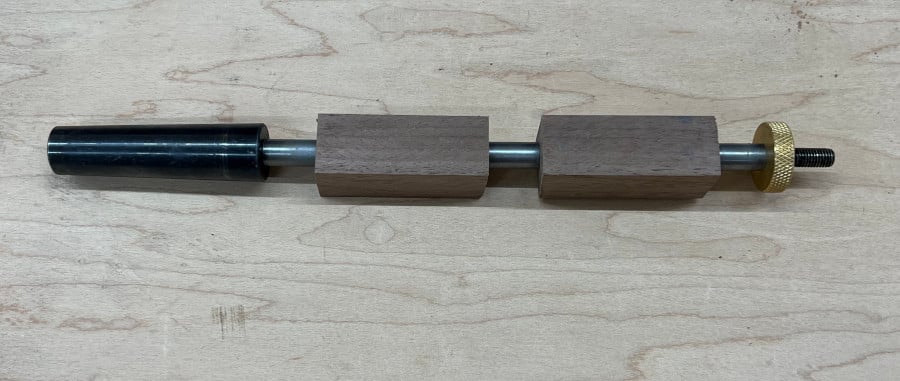If you’re new to machining or woodturning, you might have come across the term mandrel and wondered what it is. Is it one of the parts of a lathe? Or is it a lathe accessory or tool? In this article, you’ll get a simple answer to the question “what are mandrels?”, as well as general information you need to understand the uses of a mandrel and how they work.
Without further ado, let’s dive in!
What is a Mandrel?
A mandrel is a cylindrical, tapered rod (shaft or a spindle) that helps hold or shape the workpiece. Mandrels are typically made of steel and are used in hollow jobs on lathes, industrial, and jewelry machines. They shouldn’t be confused with an arbor, which holds tools rather than workpieces.
Mandrels are typically slightly tapered to provide support during machining, so a solid frictional grip between the mandrel and the hole wall is in place when pressed into a previously machined hole.
Mandrels aren’t new inventions but have seen use in the spinning process from metal machining as far back as ancient Egyptian times.
Mandrels are a lathe accessory that have mainly two uses:
- Holding the workpiece: Instead of attaching the workpiece to the chuck of the machine, a mandrel can help hold the workpiece better.
- Forging and reshaping: Ring mandrels (also called triblets) are used in the jewelry industry for forging and reshaping rings on them.
Mandrels also have specialized types and find their use in filament winding, the production of steel cores, and double-reed musical instruments.
Why do we need Mandrels?
Mandrels mostly find their use in holding a workpiece that doesn’t fit in a chuck or against a faceplate. This means any workpiece whose axis has been drilled or bored would be used with mandrels.
Mandrels make the workpiece rotate around the center only, increasing the jobs’ accuracy. Without proper support of the workpiece, there’s a chance for the job operation (e.g., drilling, boring etc.) to fail.
Several forces act on the workpiece to make it deflect away from the center, which makes the usage of mandrels necessary.
Caption: Chuck, which holds the mandrel, is shown in the image.
Types of Mandrel
Based on the uses of mandrels they can be split into two categories:
Mandrels used for holding
Mandrels used for holding the workpiece in place have different types and find their uses in the industrial, lathe, and woodworking machines. Following are the types of mandrels used for holding the workpiece:
Solid Mandrel
A solid mandrel is a cylindrical, tapered bar whose one side is larger in diameter than the other. It is the simplest type of mandrel generally available in most machine shops. It is also known as the plain mandrel.
There is a slot at both ends of the mandrel. The larger diameter end has a slot for the lathe dog, while the other has a protected center hole for the dead center. This mandrel type is used when the workpiece is plain and is available in different sizes from 44m to 450mm.
Step Mandrel
The step mandrel isn’t plain like plain mandrel but has step collars of different diameters fitted with it. This allows it to be used for various diameters of workpieces. Step mandrel is used when the inner portion of the workpiece is in the form of steps, which makes step mandrel the right choice.
Gang Mandrel
A Gang mandrel has a fixed collar at one end and a movable collar threaded at the other end. This type of mandrel allows hollow workpieces to be placed between the fixed collar and the movable collar, followed by tightening it with a washer nut.
Gang mandrel is similar to a step mandrel, except it allows multiple jobs to be machine simultaneously. Its ability to handle multiple workpieces simultaneously reduces the machining time and is thus used in mass manufacturing.
Collar Mandrel
The collar mandrel is basically a lighter plain mandrel with two fixed collars attached at both ends. The fixed collars fit firmly on the workpiece. Generally, this mandrel is used for holding workpieces with diameters above 100 mm.
Screwed Mandrel
The screwed mandrel has a fixed collar and an open threaded end to allow screwing threaded workpieces for machining purposes. This mandrel type is used when the inner part of the workpiece is threaded.
Cone Mandrel
The Cone mandrel has a fixed cone at one end and a sliding cone at the other. The sliding cone has threads and can be adjusted or removed using a nut. This type of mandrel allows it to hold different sizes of workpieces between the two cones.
Expanding Mandrel
Expanding mandrel has a slightly complex construction. It has a mounted bush over a tapered arbor, which has a tapered hole with three longitudinal cuts. Two slots are cut nearly through, while the third cut is of full length. This construction allows the expansion of split bushing within a limit.
The expanding mandrel can accommodate different diameters of workpieces ranging from 0.5m to 2mm. This range can be increased with a change in brush size.
Ring mandrels
A ring mandrel, or a triblet, is a cylindrical, tapered tool used in forging, shaping, and reshaping workpieces (mostly rings). Ring mandrels are mainly used in the jewelry industry. They can also be used for measurements if they have ring sizes on them.
Other mandrels
There are many specialized mandrels out there that are designed to fix specific problems. Following are some of these mandrels:
- Bullring mandrels: This mandrel consists of a live center with interchangeable rings that can accommodate a wide variety of large-diameter parts.
- Live Chuck mandrels: These mandrels are explicitly designed for applications where the ability to chuck both ends of the part is required. The rotational ability of the live center is combined with the flexibility of the jaw chuck. It allows rolls with damaged centers to be chucked and indicated with a 4-Jaw chuck.
- Dead Chuck mandrels: Like live chuck mandrels, these mandrels are also used where the ability to chuck both ends of the part is required. The rigidity of a dead center is combined with the flexibility of the jaw chuck for its operation. They lack the bearings found in live chuck mandrels and are used in live tailstocks.
How to use mandrels?
Mandrels used for holding
Mandrels are used for hollow workpieces when chuck alone isn’t enough. Depending on the mandrel type, there are different ways to set them up, but the principle remains the same i.e. to clamp them into the chuck with the workpiece. Solid, collar, and cone mandrels require the workpiece to be placed on them, while mandrels that have threads require the workpiece to be threaded into the mandrel and locked with a washer nut.
Following are some precautions before using mandrels:
- The mandrel must be oiled, free of burrs, and mounted between the aligned centers.
- A drive plate and lathe dog must be used wherever required.
- The workpiece should be mounted onto a lubricated mandrel using an arbor press.
- The lathe dog should be secured to the end of the mandrel rather than on the smooth surface of the mandrel taper.
- Expansion bushings, if used, should be cleaned and cared for in the same manner as a normal mandrel.
How to use a Ring mandrel
Caption: Reshaping of ring after being tapped by mallet.
If you’re making a ring from scratch, you would need a ring mandrel after going through the soldering and pickling process. To shape the band into a round ring shape, do the following steps:
- Place the ring onto the mandrel.
- Tap around the ring to form its shape using a rawhide mallet.
- During tapping, frequently take the ring off and turn it around.
- Continue tapping to ensure the ring ends up evenly round.
How do mandrels work?
Mandrels used for holding
A mandrel is essentially a support to hold the workpiece. It is designed to be used with other support components of machines like lathe dog, face plate etc. The workpiece is fitted on the mandrel, clamped into the chuck from one side and the tailstock (or some other support) from the other side.
Just like a key easily fits into its lock, a mandrel is designed to fit its specific range of workpieces for improved machining purposes.
Ring mandrels
Whenever we need to make a specific shape of an object, we need a base for it, and ring mandrels provide exactly that. Ring mandrels have ring sizes on them, so if we were to place a round bland (after the soldering and pickling process) on a ring mandrel and tap it with a rawhide mallet, we could form rings of any desired size.
Conclusion
This article aimed to provide general information regarding mandrels. Mandrels are either used to hold a workpiece or reshape it. Specialized mandrels may be for specific purposes.
Mandrels used for holding make the workpiece rotate around the center only, increasing the job’s accuracy. Meanwhile, the ring mandrels are used to forge or reshape rings.
For further study, you may refer to the following:
Manufacturing Technology – II – Dr. R.Kesavan, B. Vijaya Ramanath – Google Books

